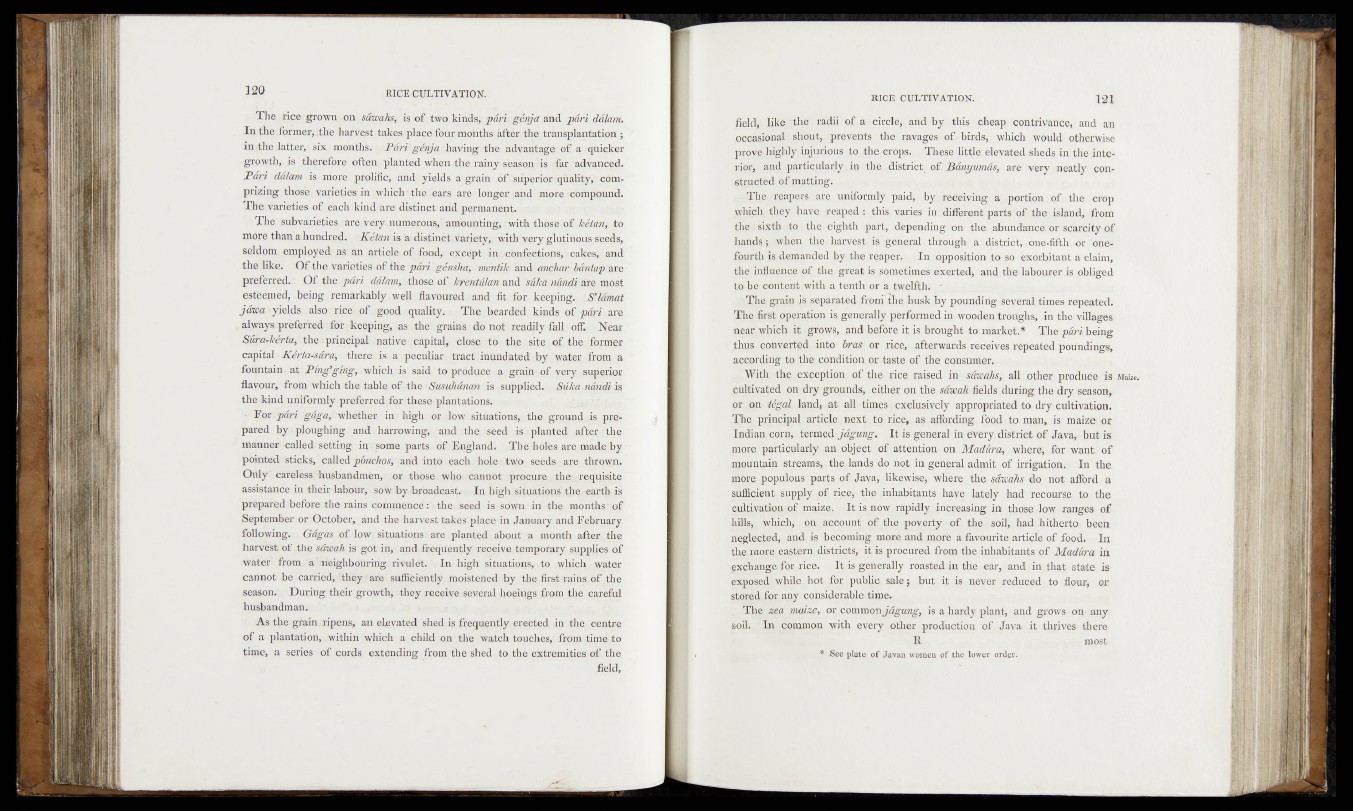
| The rice grown ork-savoahs, ismf twul^dsp.puró gérya saA pari ddlarn.
In thè:&fmm,„Thterhafkest; takes tplabêfóup months aft-errtbe transplantation;
insthe latter,: six months, : P an 'igénga "havingr the advantage* of, a /quicker
grpwth, is ..tlierelpre-'qftjn* planted when the_ rainy seasons :is rfarr advanced.
Part dalam is more prolific; <and,;yipldS( a grain óf superior? quaKfcjy cdm-
prizing, th.ósb' varieties' in which uthe ..ears are longer and uriore "compound.
Tttè/yafieties’ofi, each-kind." a^eadisfinct arid permanent.-*^
Thevarieties^*are,venylnumerous,, amounting, ‘with thq&elof Mtam to
more than a-hundred.-. riföefomis ia’--di§tinct\variety,' with Very glutinous seeds,
seldpm, enaplpyed-,. asr^n ar.tiel,|) ofi-food;- ■:except ^ ^ cbnfebtions,- cakes, and
thei like.’ ‘Ofitthe .Varietiesr oft fire cpdri l génsha; t\7ffmUk :and i anchor,' bdntap^te
preferred.- ■ddlam,: those’o f!kr’entdlan,and sulca nandi are most
es^qméd,lbeing. remarkably t well flavoured-; and fit-for., keeping;: iS ’ldmat
jn*éa> yields -also) r-iheiiofirgno^: quality.. nThfet bearded kinds1 .pf-.pari^ai'e
alwayst preferredt for keeping, as the grains do^rrot readily fall oflinyN.par
Sófya-kérfai the principal .’native capital,. ïtcfesaVto theusW^qf^fbe, : former
capital •• Kertu-sÉrd,, thereJ is. a vpeculiar, tract' inünd atéd cby ;iv?atej§r^pm;;a
fountain- at Ptngigmg, .whichiris said to produce a -grafn-t of-yer.y- superior
flayour, - fromwhich'the table -of/fhe 'Susuhtinan is, supplied.. Suha^rwmdi is
thé kind uniformly preferred for--theserplantations.
■ Ttovpwri’ ^•«J’ajLwhether in: high .or low situations,-theigiguniJ^jprepared
by-ploughing and - harrowing*-'ancL. the; -^pednsis < planiedi,.;aft^ f the
manner>calledisetting. irpsome parts of.England. fiXTh^diofes^are -madethy
pofcited*-sticks,-'called pónchos, and into each-holen tmo, seeds,t are.jthrQ.wn,
Orilyj cSrèléssfhusbandmèn,' or those, who?-caBnM^^ocure.itheiferepuisife
assistance in their labour, cow by ‘broadcast. In high 'situafions'! the fearth is
prepared beforeijthe 'rains commence' father seed ■ *is#sri^n_ ini t the <LtoópSaSIgrf
September, or, October, and the harvest takes pla^pjin January and February
following., Gdgas .of.dowr situations .are planted ah^ut,.a .month afte^the
harvest of the sarwah is got.in,* and, frequently! receive*temporary supplies of
water from/a ’-neighbouring rivuldteJ*. In high' situations, to iwjhich pwater
cannot jre cailriedp-théy ïafê sufficiently; .moistened by the first rainsi of the
season.. During their. growth' -they -receive several hoeirigs:from the careful
husbandman.
As thegrain iripens, an elevated 'shed:is frequently, erected in the centre
of a plantation,-within which. aTchild on the watch, touches,' from time,to
time, a series of cords extending from'the shed to the extremities of the
field,
fields like *the r radii, of a circle,, .and; by, Jhis^ -cheap, contrivance, and an
qoc^tQn^^e^fepr&ypnls ravages.pf^.bir,ds,, which would otherwise
proyerhighly iniiu-aelispi& the, crons. ,:!fhps^Mrt^Ie elevated;,She4| in the interior,
yanTfarti0 u l a r l y , r i&J ; r i c%oS^-B'g^y,timqs, "are yery -neatly constructed
of^prattiqgi - ;
..reapers ate -uniformly paid, by receiving- a portion of the crop
ypjjjgdth^-have,.leaped,: this Varies in different parts o f thepisl'and, from
$5? fcsixth tq^the^Sghjth ‘ part, (d,epehding. on,: the^fa^un|#i’d ^ o | scarcity of
hands the fharvest-.isjg&uhralpthreugh a district*- pne-fifthhor 'one^
demanded by .the reUpeiay In opposition to^sh exorbitant a clttimi
the influe^gi^fjjbhe,great is sqrpetimes .exerted; and the labourer"is obliged-
tMb.et1 pp^tpptwith a tenth'or a.-iyjelfthf -r-y
- \Ehe grain .is* separated frqnf the husk by pounding several times repeated.
The fustsppejation is-generally performed in woo,den< troughs,,, in the villages
pear-which it^gyows, and.before it is brought to markets .The pari being
„rims,.cpn^er^qdr,into bras, or- rice,,- afterwards receives repeated poundings,,
aa^djgg.to, the-con,chtio,n.(1®r taste of the- consumer.
. CWitlk, t^i.expep.tion^o£:th&. rice raised in :sdwahs, all other produce, is
cultivated on-'d^y grounds,- either on the satoah fields during the dry season*
or*@n tfeg^.Jand, at all tidies ^exclusively appropriated to» dry cultivation.
The prin^Bal^a-rticle^riext, to- rice, as affording food - to. man, is maize or
Imdianscprn,.' termed jagung. It is general in eVery district of Java, but is
more feti^ulajlyj^.ri^^^cfc of attention on Madeira, where,-for want' off
mountain streams, thg-lands do. npfi in general admit;,of irrigation.- In the
mc^e*,pppplnns'.parts of Java, likewise, where the sdwahs do -not;nffQrd a
sufficient supply, of rice,- the inhabitants have, lately had' recourse; to.-- the
cultivationApf, maize. It .is now rapidly increasing in- those low j ranges of
hauS.-^ whmh. ;Opf,accmmt of the poverty,'of the-, soil, had hitherto- been
neglected, and is becoming more and more a favourite article of food* In
the-morp ea§fern-_distriets,: it'is procured from the inhabitants of Madiira in
exchange for-.qice. is generally roasted in the. ear, and. in that state is
exposed hqftfor public- sale; but it is* never reduced- to 'flour, ox,
stored for .any considerable time,
. . T|ip .Me# maize, or common jagung* is a hardy plant, and- grows on any
soil. In common with every other production of Java it tbasfves there
It : most
,..; * See plate of Javan women of the lower order.
Maize.